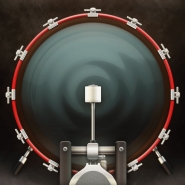shogun
MyBoerse.bz Pro Member
DrumKick

Diese App wurde sowohl für das iPhone als auch für das iPad konzipiert
Kategorie: Musik
Aktualisiert: 22.12.2015
Version: 1.2.0
Größe: 50.1 MB
Sprache: Englisch
Entwickler: Mark Jeschke
© 2013-2015 Mark Jeschke
Kompatibilität: Erfordert iOS 7.0 oder neuer. Kompatibel mit iPhone 3GS, iPhone 4s, iPhone 5, iPhone 5c, iPhone 5s, iPhone 6, iPhone 6 Plus, iPhone 6s, iPhone 6s Plus, iPad, iPod touch (3. Generation), iPod touch (4. Generation), iPod touch (5. Generation) und iPod touch (6. Generation).

telefonbuch
Beschreibung

DrumKick is the only stereo drum app that allows you to play the kick drum with your foot!
With DrumKick installed on two iOS devices, such as an iPad and an iPhone, you can use the iPhone as a Bluetooth remote to play the kick drum with your foot! It also works with two iPhones or iPod touches. Or, you can mix and match.
How does it work?
Playing the virtual kick drum pedal is achieved by inserting the iPhone (upside down) into a snug fitness band that's wrapped around your ankle, or the front tube of your relatively clean crew sock. Tap your toes with your heel down, and the iPhone's accelerometer will trigger the kick drum sound on the iPad via Bluetooth.
Feature Highlights:
• Play any of DrumKick's available sounds, using the iRig BlueBoard MIDI Bluetooth or KMI SoftStep foot controller.
• Play the kick drum sound with your foot, using a second iOS device via Bluetooth.
• High-quality drum stereo sounds with independent control of their volume, pitch and pan levels.
• Low-latency with drum taps and sounds.
• Retina-enhanced, interactive, 3-D animated drums and cymbals.
• Optimized for iPad Air 2 and iPhone 5s.
• Multiple tap regions for triggering different drum and cymbal sounds.
• Ability to switch the drum kit's audio output from stereo to mono when connected to stereo speakers, such as a P.A. system.
• Touch-hold on the crash cymbal for a choked cymbal* muting effect.
• Audiobus & Inter-App Audio support (iOS7+) for adding effects apps to DrumKick's output and recording into to GarageBand, Loopy, or AudioShare.
• Core MIDI IN & OUT support, thanks to Nic Grant of Audeonic Apps for his robust MidiBus Library ( ) and generous help.
• Jam along with music apps that run in the background, such as GarageBand, Pandora, or your iPod music library.
• Minimum requirements: iPad 1, iPhone 3Gs, and iPod touch (3rd generation), running iOS 4.3 through iOS 7. Although this version states iOS 7 only, you can still download the prior iOS 7 build of DrumKick, which runs on iOS 4.3 - iOS 6.1. iPad 2, iPhone 4S and newer devices are recommended.
* No cymbals were harmed during the making of this app.
DrumKick is not just for professionals. Kids and toddlers love playing it, too! The best part about it is volume control and the headphone jack!




Diese App wurde sowohl für das iPhone als auch für das iPad konzipiert
Kategorie: Musik
Aktualisiert: 22.12.2015
Version: 1.2.0
Größe: 50.1 MB
Sprache: Englisch
Entwickler: Mark Jeschke
© 2013-2015 Mark Jeschke
Kompatibilität: Erfordert iOS 7.0 oder neuer. Kompatibel mit iPhone 3GS, iPhone 4s, iPhone 5, iPhone 5c, iPhone 5s, iPhone 6, iPhone 6 Plus, iPhone 6s, iPhone 6s Plus, iPad, iPod touch (3. Generation), iPod touch (4. Generation), iPod touch (5. Generation) und iPod touch (6. Generation).

telefonbuch
Beschreibung

DrumKick is the only stereo drum app that allows you to play the kick drum with your foot!
With DrumKick installed on two iOS devices, such as an iPad and an iPhone, you can use the iPhone as a Bluetooth remote to play the kick drum with your foot! It also works with two iPhones or iPod touches. Or, you can mix and match.
How does it work?
Playing the virtual kick drum pedal is achieved by inserting the iPhone (upside down) into a snug fitness band that's wrapped around your ankle, or the front tube of your relatively clean crew sock. Tap your toes with your heel down, and the iPhone's accelerometer will trigger the kick drum sound on the iPad via Bluetooth.
Feature Highlights:
• Play any of DrumKick's available sounds, using the iRig BlueBoard MIDI Bluetooth or KMI SoftStep foot controller.
• Play the kick drum sound with your foot, using a second iOS device via Bluetooth.
• High-quality drum stereo sounds with independent control of their volume, pitch and pan levels.
• Low-latency with drum taps and sounds.
• Retina-enhanced, interactive, 3-D animated drums and cymbals.
• Optimized for iPad Air 2 and iPhone 5s.
• Multiple tap regions for triggering different drum and cymbal sounds.
• Ability to switch the drum kit's audio output from stereo to mono when connected to stereo speakers, such as a P.A. system.
• Touch-hold on the crash cymbal for a choked cymbal* muting effect.
• Audiobus & Inter-App Audio support (iOS7+) for adding effects apps to DrumKick's output and recording into to GarageBand, Loopy, or AudioShare.
• Core MIDI IN & OUT support, thanks to Nic Grant of Audeonic Apps for his robust MidiBus Library ( ) and generous help.
• Jam along with music apps that run in the background, such as GarageBand, Pandora, or your iPod music library.
• Minimum requirements: iPad 1, iPhone 3Gs, and iPod touch (3rd generation), running iOS 4.3 through iOS 7. Although this version states iOS 7 only, you can still download the prior iOS 7 build of DrumKick, which runs on iOS 4.3 - iOS 6.1. iPad 2, iPhone 4S and newer devices are recommended.
* No cymbals were harmed during the making of this app.
DrumKick is not just for professionals. Kids and toddlers love playing it, too! The best part about it is volume control and the headphone jack!



Zuletzt bearbeitet:








